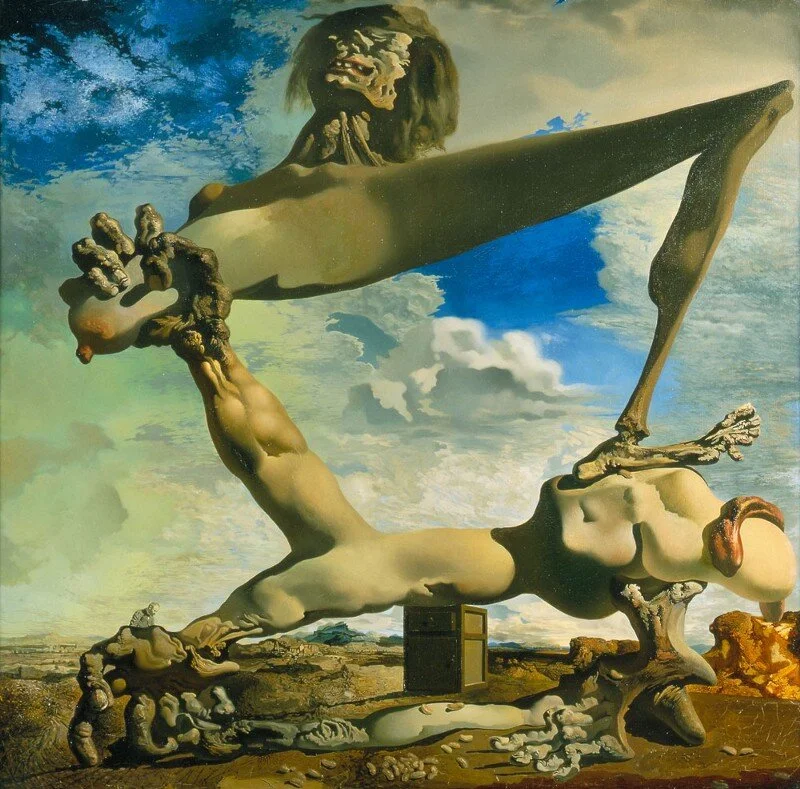Dubois Pennsylvania is to Hillbillies what Williamsburg Brooklyn is to Hipsters — a Mecca of insulated culture with its own language, fashion, attitude and values. Both populations share a common love, however.
Tattoos.
The norms for each province are considered violently different by both. That said, thousands of canvas owners can be heard, in either place, requesting a “flying tiger engulfed in flames, with a single eyeball hovering above its right paw, surrounded by angels playing Zen flutes, all wrapped in a tribal design”.
A Brit’s screed
Yesterday, I watched a ten minute YouTube clip of a Brit who hates contemporary art to the point that I felt sorry for him — and I’m a guy who struggles with compassion. His distress was loud, extended and, to me, hilarious, which would probably have made him apoplectic if he’d witnessed my crying.
The experience was preceded by a social media faux pas I made recently. At Sotheby’s, within the last several months, a Minimalist painting by Barnett Newman sold for $44 million. I discovered the sale while scrolling Zuckerberg’s soul. An acquaintance’s post linked to an article about the artwork and the price. The most prominent and common theme among numerous comments was the price paid.
The comments were, well…American.
American?
Yes. American. Our culture, more than any other on the planet, attaches a value to every asset — a house, a shoe, a can of soup. We love both depreciation and appreciation so long as we are on the side that benefits.
Everything — everything — gets compared to something we understand personally. Our penchant for the free market, and the psychology of the contrary, is a case in point. Stand too far above your peers and one can be assured that they will tear you down. Alternatively, offer a self-deprecating remark about precisely the same topic for which they would tear you down and they will assure you that you are far better than your remark supposes. In a country where hard work, merit and fairness is valued above all else, how could it be otherwise?
All art is shite
The Brit contends that the overwhelming majority of contemporary artwork, with an emphasis on conceptual art, is, to use his word, “shite”. He pointed to a specific artwork that was, in fact, three canisters of shit, so it’s hard to defend that particular piece. That said, I am giddy at the possibility that he either: a) went looking for the canisters to support his belief or b) was scrolling through Facebook and was presented with a GIF of somebody putting three canisters of shit on a pedestal in a London Gallery — with a hefty price tag.
Forghorn Leghorn incarnate
I worked in a car dealership, selling cars, in the past. Our finance manager was seventy-seven inches of crunchy-haired, parochial, obnoxious Jello. Monotone and glibly exasperated, his diatribes were bathed in a megaphone-shaped mist of sweated cheesesteak grease and tunnel vision. Never was he wrong about anything; especially his observation that all art is “gay”.
When he found out that I was an artist, in the context of proving that he was right about art, he would run across the showroom at me, like a bull running the streets of Pamplona, his fist holding his iPhone at arm’s length, with a piece of “modern” art on the screen. Like a dangling penis in his bloated hand, his phone offered proof, in his mind, that every painting is a rigid member waiting to attack a hungry anus.
His ideas were surreal and I know a hundred people just like him. He’s not a Hillbilly, but it’s good to have goals.
Last week at the Philadelphia Art Museum
I was standing in the Arensburg collection, in front of the Salvador Dali painting shown here — Soft Construction with Boiled Beans (Premonition of Civil War). Two retired couples drifted through the galleries as if following me on a moving airport sidewalk. The wives were chatting, giving each piece some attention. The husbands were far from ambivalent. Each artwork was more egregious than the preceding. Clearly, they were onto the scam in a way only the Brit’s screed could ever be.
They remarked, too, that the entire museum was gay. And, in fact, that all contemporary art was a scam. Their tattoos were old but spectacular, and expensive if commissioned today.
After hearing the men’s discourse for ten minutes, I stopped to listen and watch, with an instinct that Dali’s Surrealism might speak to them. It did. Hillbillies, truck drivers, high school students, intellectuals, farmers, mechanics and fast food workers all love Salvador Dali.
In particular, in the above painting, the “hand grabbing the boob” appealed to their die-hard heterosexuality, as did the feeling that the image was a dream that either could have had the night before.
Of course, both wondered what the artwork was worth. But, for a minute, before they compared it to a house, a shoe or a can of soup, they actually saw the work and enjoyed it on a visceral level. The image took them outside themselves.
Because the work skipped within a stone’s throw of each of their imaginations, its value as art was justified. Because each might consider tattooing the image on their forearm or back, the art wasn’t a scam.
If they would allow an artist to lean on them, skin to skin, with an a elbow in the small of their back, jabbing a needle into their flesh thousands of times, that they’d be able to showcase ownership of a painting worth ten million dollars with their brethren, over an Egg McMuffin, at breakfast the next morning, then it definitely wasn’t gay.
I love Salvador Dali. I’m from Dubois.
—

